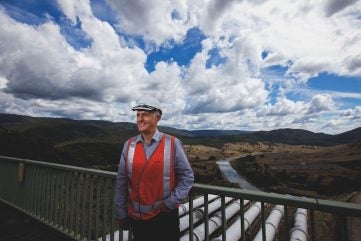
“Without accelerated development of pumped storage hydropower (PSH) the transition to renewables will falter, and fail,” Malcolm Turnbull, President of the International hydropower Association (IHA) said. “The failure to adequately focus on this need for long duration electricity storage is the ignored crisis within the energy crisis,” he added.
However, despite the need for such important long duration storage, pumped storage projects are still facing significant challenges which means that there’s a lack of projects progressing to construction, with cost and schedule overruns.
“The sector is too important to fail”, said Chris McMonagle, Global Business Development Manager at Bechtel. “We need to do better and address these challenges.”
Urging the industry “to get its act together” Turnbull re-iterated that PSH must be developed in a sustainable and environmentally responsible manner. This includes addressing concerns about potential investment risks, as well as ensuring the public understands that PSH is very different from conventional hydropower.
New guidance for pumped storage projects
With the above in mind, a new guide has been launched to provide key decision-makers with recommendations for de-risking investments in pumped storage. It was developed by a working group with members from across the pumped storage hydropower industry, chaired by Bechtel Corporation and supported by the secretariat of the IHA. Amongst working group members were Brookfield Renewables, the European Investment Bank, British Hydropower Association, GE Vernova, Stantec, KPMG, Mott Macdonald, the World Bank Group, Queensland Hydro, Dentons LLP, and the University of Cambridge.
As Working Group Chairman Chris McMonagle explained, the approach taken was to discuss the multiple risks and issues faced by all players in the sector, categorise these into thematic areas, identify those causing the greatest barriers to success, and then provide recommendations on how the major risks and issues should be addressed.
“We agreed early in the process that it was important that we reach a collective view on how we can ‘de-risk the project’, not simply de-risk from any one participant’s point of view,” McMonagle said. “We wanted to provide guidance for key decisionmakers, ie, policymakers, investors, off-takers, owners/developers, and the supply chain, so that they understand the unique risks and barriers to PSH development and are able to make early, informed decisions which will shape the development process to ensure reliability and confidence in delivering projects.”
Described as being the outcome of “excellent analysis, healthy debate, and open sharing of industry best practice”, the guidance note will enable new market entrants to better understand the risks and create a mitigation strategy to address them. Key decision makers are also encouraged to adopt the recommendations to enable the industry “to deliver sustainable, affordable, reliable power for all”.
Members of the working group gave their views of why such a guidance note was so important.
“I have been working on PSH projects for over 35 years both for new construction and refurbishments and have seen many more projects fail in the process than I have seen succeed,” said Donald Erpenbeck, Vice President and Global Sector Leader for Dams & Hydropower at Stantec. “I continue to be surprised by experts/owners who oversimplify PSH and/or developers/owners who take PSH for granted in the energy transition mix. PSH Is one of the most technically difficult projects in the heavy civil works and the only thing more complicated than the technical is the financial/commercial aspects….It is my hope that the guide produced by this group will increase the success rate of PSH projects in the development cycle and bring more projects to financial close in a more streamlined manner.”
Amongst others, the guidance note raises the issue that the key risk to pumped storage hydropower is the difficulty in establishing a firm (bankable) revenue forecast in the absence of government support and regulation or a clear market mechanism, said Judith Plummer Braeckman, from the University of Cambridge Institute for Sustainability Leadership “Overcoming this risk is key to unlocking the power of pumped storage to support the grid in absorbing large amounts of variable renewable energy,” she added.
And as Jérôme Bridon, Senior Product Marketing Manager, GE commented: “To help reduce risks, ensure availability of skills and resources, and accelerate the development of pumped storage projects, collaboration between stakeholders along the value chain and supporting policies offering greater visibility are essential.”






